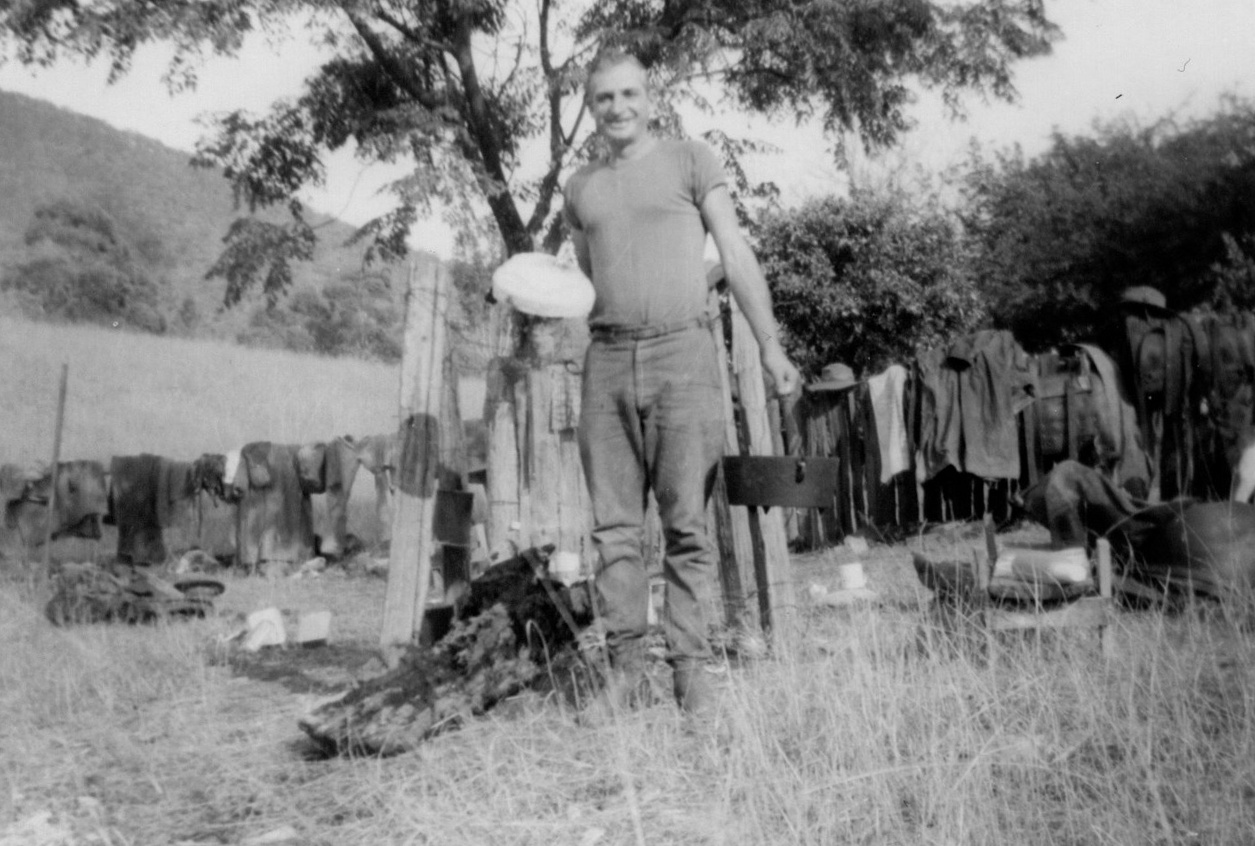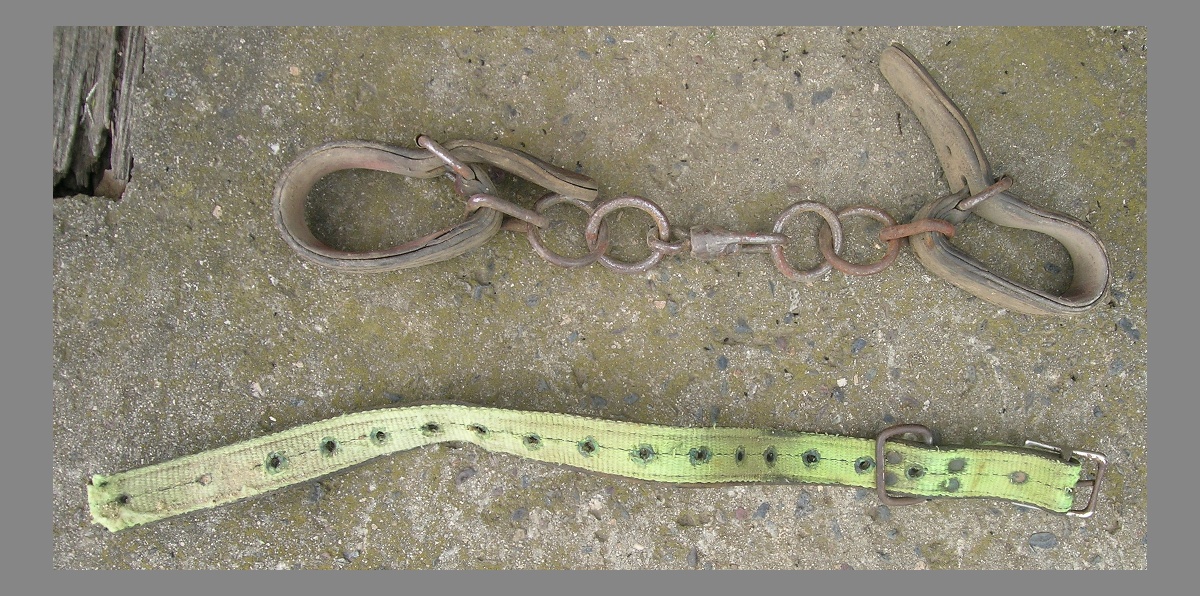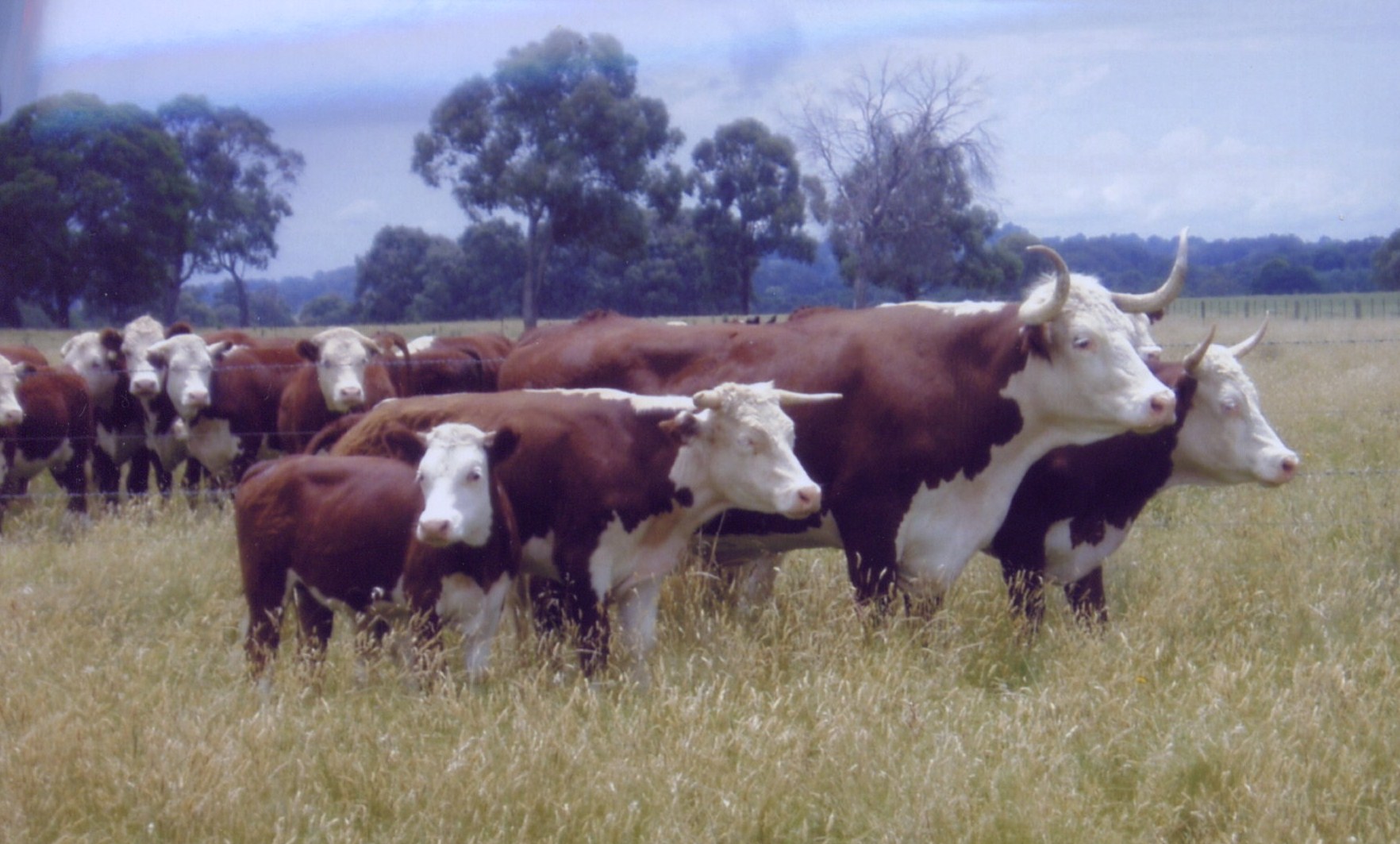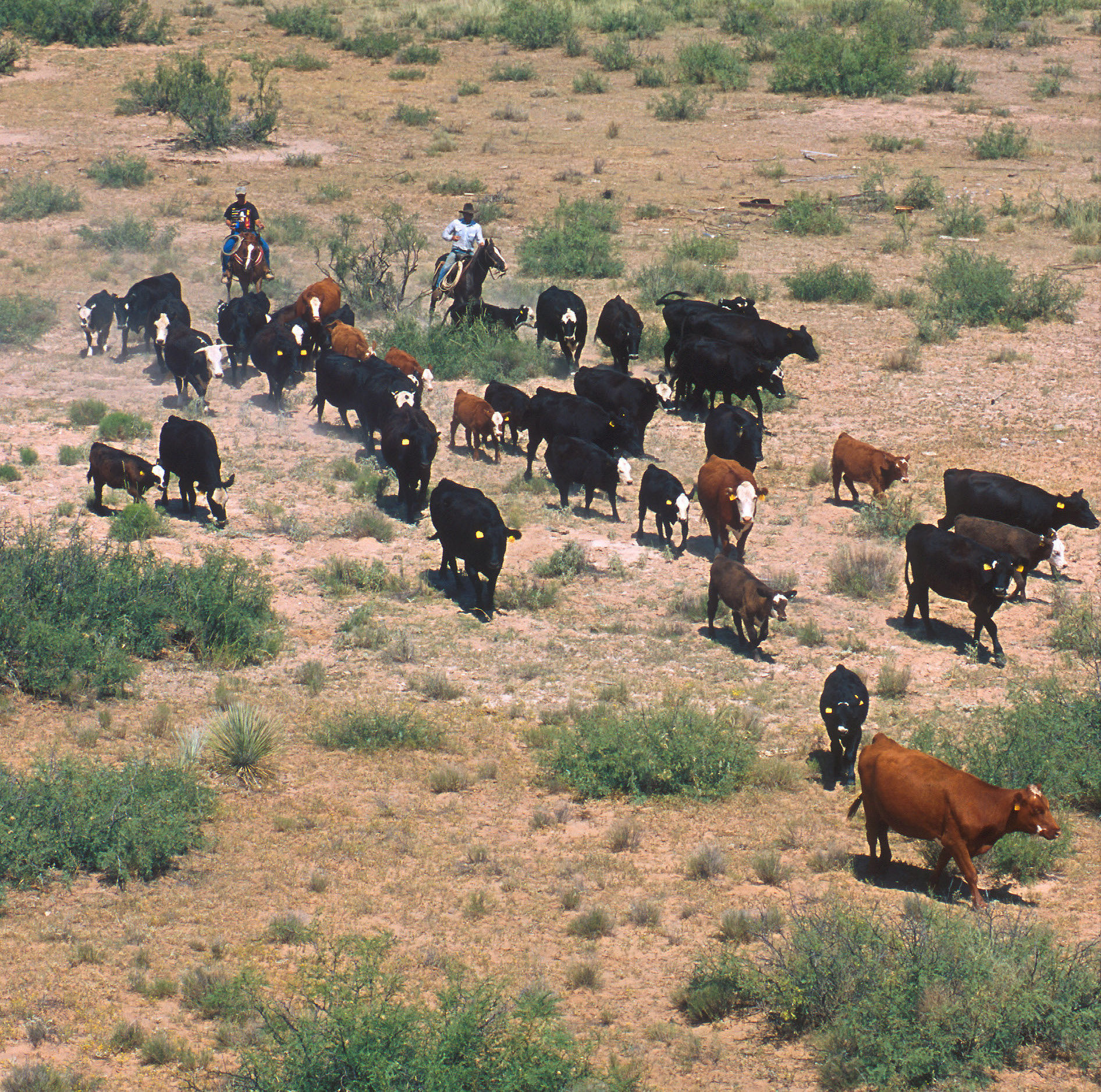Muster (livestock) on:
[Wikipedia]
[Google]
[Amazon]




 A muster (Au/NZ) or a roundup (US/Ca) is the process of gathering
A muster (Au/NZ) or a roundup (US/Ca) is the process of gathering


 The North American roundup was an iconic image of the
The North American roundup was an iconic image of the
The micky bull
Australian English Livestock in Australia




livestock
Livestock are the Domestication, domesticated animals that are raised in an Agriculture, agricultural setting to provide labour and produce diversified products for consumption such as meat, Egg as food, eggs, milk, fur, leather, and wool. The t ...
. Musters usually involve cattle
Cattle (''Bos taurus'') are large, domesticated, bovid ungulates widely kept as livestock. They are prominent modern members of the subfamily Bovinae and the most widespread species of the genus '' Bos''. Mature female cattle are calle ...
, sheep
Sheep (: sheep) or domestic sheep (''Ovis aries'') are a domesticated, ruminant mammal typically kept as livestock. Although the term ''sheep'' can apply to other species in the genus '' Ovis'', in everyday usage it almost always refers to d ...
or horse
The horse (''Equus ferus caballus'') is a domesticated, one-toed, hoofed mammal. It belongs to the taxonomic family Equidae and is one of two extant subspecies of ''Equus ferus''. The horse has evolved over the past 45 to 55 mi ...
s, but may also include goats
The goat or domestic goat (''Capra hircus'') is a species of goat-antelope that is mostly kept as livestock. It was domesticated from the wild goat (''C. aegagrus'') of Southwest Asia and Eastern Europe. The goat is a member of the famil ...
, camels
A camel (from and () from Ancient Semitic: ''gāmāl'') is an even-toed ungulate in the genus ''Camelus'' that bears distinctive fatty deposits known as "humps" on its back. Camels have long been domesticated and, as livestock, they provide ...
, buffalo or other animals. Mustering may be conducted for a variety of reasons including routine livestock health checks and treatments, branding
Branding may refer to:
Physical markings
* Making a mark, typically by charring:
** Wood branding, permanently marking, by way of heat, typically of wood (also applied to plastic, cork, leather, etc.)
** Livestock branding, the marking of animals ...
, shearing
Sheep shearing is the process by which the woollen fleece of a sheep is cut off. The person who removes the sheep's wool is called a '' shearer''. Typically each adult sheep is shorn once each year (depending upon dialect, a sheep may be sai ...
, lamb marking, sale, feeding and transport or droving
Droving is the practice of walking livestock over long distances. It is a type of herding, often associated with cattle, in which case it is a cattle drive (particularly in the US). Droving stock to market—usually on foot and often with the ...
to another location. Mustering is a long, difficult and sometimes dangerous job, especially on the vast Australian cattle station
In Australia and New Zealand, a cattle station is a large farm ( station is equivalent to the American ranch), the main activity of which is the rearing of cattle. The owner of a cattle station is called a '' grazier''. The largest cattle stati ...
s of the Top End
The Top End of Australia's Northern Territory is a geographical region encompassing the northernmost section of the Northern Territory, which aside from the Cape York Peninsula is the northernmost part of the Australian continent. It covers a ...
, 'The Falls' (gorge) country of the Great Dividing Range
The Great Dividing Range, also known as the East Australian Cordillera or the Eastern Highlands, is a cordillera system in eastern Australia consisting of an expansive collection of mountain ranges, plateaus and rolling hills. It runs roughl ...
and the ranch
A ranch (from /Mexican Spanish) is an area of landscape, land, including various structures, given primarily to ranching, the practice of raising grazing livestock such as cattle and sheep. It is a subtype of farm. These terms are most often ap ...
es of the western United States
The Western United States (also called the American West, the Western States, the Far West, the Western territories, and the West) is List of regions of the United States, census regions United States Census Bureau.
As American settlement i ...
. The group of animals gathered in a muster is referred to as a "mob" in Australia and a "herd" in North America.
Methods
Mustering may be done on foot, with various vehicles, horses or with aircraft. Techniques in mustering cattle or sheep will depend on region, culture, distances and the type of terrain involved, and the type of animal that is being mustered. Most sheep mustering nowadays tends to be done with utes,motorcycle
A motorcycle (motorbike, bike; uni (if one-wheeled); trike (if three-wheeled); quad (if four-wheeled)) is a lightweight private 1-to-2 passenger personal motor vehicle Steering, steered by a Motorcycle handlebar, handlebar from a saddle-style ...
s or all-terrain vehicle
An all-terrain vehicle (ATV), also known as a light utility vehicle (LUV), a quad bike or quad (if it has four wheels), as defined by the American National Standards Institute (ANSI), is a vehicle that travels on low-pressure tires, has a seat ...
s (ATVs, commonly called "quads" (quad-bikes) in Australia or a "four-wheeler" in the US), whereas cattle mustering lends itself more towards the use of horse
The horse (''Equus ferus caballus'') is a domesticated, one-toed, hoofed mammal. It belongs to the taxonomic family Equidae and is one of two extant subspecies of ''Equus ferus''. The horse has evolved over the past 45 to 55 mi ...
s. The most popular horse for this job would is a stock horse or a very hardy bush horse. The people who muster animals are usually referred to as stockmen in Australia and, depending on the animal gathered, as wranglers or cowboy
A cowboy is an animal herder who tends cattle on ranches in North America, traditionally on horseback, and often performs a multitude of other ranch-related tasks. The historic American cowboy of the late 19th century arose from the ''vaquero'' ...
s in the US.
Dogs are typically used where it is possible or helpful to do so. The hardy Australian Kelpie or one of its crosses is the most popular breed of dog for mustering sheep and cattle in Australia. The Australian Cattle Dog
The Australian Cattle Dog, or simply Cattle Dog, is a breed of herding dog developed in Australia for droving cattle over long distances across rough terrain. This breed is a medium-sized, short-Coat (dog), coated dog that occurs in two main ...
or "blue heeler" is a popular ranch dog in the US, as is the Border Collie
The Border Collie is a British list of dog breeds, breed of herding dog of the collie type of medium size. It originates in the region of the Anglo-Scottish border, and descends from the traditional Sheep dog, sheepdogs once found all over the ...
, Australian Shepherd
The Australian Shepherd is a breed of herding dog from the United States. The name of the breed is technically a misnomer, as it was developed in California in the 19th century. It is believed to have its origins in sheepdog breeds from northwe ...
, and related crossbreds. It may be difficult or impossible to use dogs in hot, dry or burry conditions. The use of some dogs on cows with young calves may be counterproductive as cows will chase dogs that work too close to them. Working dogs are essential in the rugged gorge country and also in scrubby locations where dogs are able to flush out cattle from low brush. The flight zone, too, is an important principle to remember when working or mustering livestock. When mustering cattle in isolated gorge country a good dog will silently move ahead of the stockman and block up the stock until the rider appears to take control. In Australia, a stockwhip is usually carried and used as needed when mustering cattle with horses. In North America, a lasso
A lasso or lazo ( or ), also called reata or la reata in Mexico, and in the United States riata or lariat (from Mexican Spanish lasso for roping cattle), is a loop of rope designed as a restraint to be thrown around a target and tightened when ...
is used from horseback, both to rope and move particularly recalcitrant animals, but also as a simple goad. However, a different style of whip, also called a "stock whip," may be utilized by handlers on the ground.
If only part of the mustered mob of cattle is required then the selected animals may be open " campdrafted away" (AU) or " cut out" (US) from the mob while contained in a large fenced area and driven away. This practice normally requires several skilled riders, but saves time and is better than yard drafting.Beattie, William A., Beef Cattle Breeding & Management, Popular Books, 1990,
The seasonal mustering of cattle with horses is still very important in remote country and the stockmen will spend long days riding and camping in isolated areas. When cattle have to be castrated
Castration is any action, surgical, chemical, or otherwise, by which a male loses use of the testicles: the male gonad. Surgical castration is bilateral orchiectomy (excision of both testicles), while chemical castration uses pharmaceutical ...
or ear marked in country that is too remote from fenced-in areas ("yards"-Au, "corrals"-US), they have to be thrown. This is accomplished by various methods. In the US, roping the animal and tying up its legs once thrown is a common method. In Australia, the common method is getting the beast off balance either with the pressure of a horse or in open country with a vehicle. Lighter beasts may also be thrown by holding the tail to pull them off balance. When downed the beast may have its back legs hobbled if it is too big to hold otherwise. In South America, the animal is often tripped with a bola and then hobbled or tied once down.
Livestock can also be passively mustered by trap yards (Au) or holding corrals (US), which are set up at points where enticements such as water, molasses, fodder
Fodder (), also called provender (), is any agriculture, agricultural foodstuff used specifically to feed domesticated livestock, such as cattle, domestic rabbit, rabbits, sheep, horses, chickens and pigs. "Fodder" refers particularly to food ...
or salt are placed. This method can be an effective and efficient technique for mustering in timbered country or for capturing feral
A feral (; ) animal or plant is one that lives in the wild but is descended from domesticated individuals. As with an introduced species, the introduction of feral animals or plants to non-native regions may disrupt ecosystems and has, in som ...
animals. A trap yard can be set up around a designated point and the animals can be trained to use the yard over a period of weeks before the gates are closed to outward movement. Sometimes quiet coaxers (coachers) are used to assist in the mustering and droving
Droving is the practice of walking livestock over long distances. It is a type of herding, often associated with cattle, in which case it is a cattle drive (particularly in the US). Droving stock to market—usually on foot and often with the ...
of wild or feral livestock.
One of the most difficult animals to muster are aged feral steers (US) or piker bullocks (AU), which were "micky bulls" (uncastrated young male cattle) that were caught, castrated and then later lost and grew up in the wild.Coupe, Sheena (ed.), Frontier Country, Vol. 1, Weldon Russell Publishing, Willoughby, 1989, These bullocks often tend to live alone and are usually stronger than cows and young cattle.

Helicopter
A helicopter is a type of rotorcraft in which Lift (force), lift and thrust are supplied by horizontally spinning Helicopter rotor, rotors. This allows the helicopter to VTOL, take off and land vertically, to hover (helicopter), hover, and ...
s are now a valuable tool in mustering large areas; they are used to locate the cattle and will then assist the mounted stockmen to yard the cattle. Helicopter mustering pilots require a cool head and lightning reflexes, as the chopper as they fly works in their own dust close to the swaying treetops. Working so close to the ground, wind is another major consideration for these pilots. These pilots also need the special skill of good 'stock sense' so as not push the cattle too hard or fast. Planes are mainly used for spotting stock and notifying the stockmen on the ground of their location via a CB radio.
Foot mustering is usually reserved for rounding up quiet or small mobs that are close to the designated destination. This method may also be used in the Southern Alps of New Zealand where it is considered too steep to safely use horses. In this case the stockman and his dogs would be lowered from a helicopter onto the higher slopes to bring the sheep down, possibly before winter. The New Zealand stockmen usually use Huntaway dogs for driving sheep away and the Border Collie
The Border Collie is a British list of dog breeds, breed of herding dog of the collie type of medium size. It originates in the region of the Anglo-Scottish border, and descends from the traditional Sheep dog, sheepdogs once found all over the ...
is also popular for heading work.
Low stress stock handling schools are now regularly run to educate graziers, stockmen and some helicopter
A helicopter is a type of rotorcraft in which Lift (force), lift and thrust are supplied by horizontally spinning Helicopter rotor, rotors. This allows the helicopter to VTOL, take off and land vertically, to hover (helicopter), hover, and ...
pilots in the working of cattle especially, and sheep as well. Drones are also being investigated, with promising results from early tests.
Australian Top End
Aboriginal stockmen played a large part in the life of Top Endcattle station
In Australia and New Zealand, a cattle station is a large farm ( station is equivalent to the American ranch), the main activity of which is the rearing of cattle. The owner of a cattle station is called a '' grazier''. The largest cattle stati ...
s. These men and women were splendid stockmen and were an integral part of the musters. Mustering in the Top End
The Top End of Australia's Northern Territory is a geographical region encompassing the northernmost section of the Northern Territory, which aside from the Cape York Peninsula is the northernmost part of the Australian continent. It covers a ...
is conducted during the dry season
The dry season is a yearly period of low rainfall, especially in the tropics. The weather in the tropics is dominated by the tropical rain belt, which moves from the northern to the southern tropics and back over the course of the year. The t ...
from April to September when additional stockmen will be employed for the purpose. Initially, mustering here involved having stock camps where about three to seven ringers under a head stockman or overseer rode out with the horses to the area to be mustered. The musterers started early each day by bringing up the hobbled horses, saddling up and then spending a long day mustering, branding, castrating and drafting the cattle. These long days were hard on man and beast with each having to contend with the heat, dust and flies. The men endured camping on the ground and had a monotonous diet of meals that were cooked on an open fire, usually by an unskilled cook.
Aggressive, rogue bulls or buffalo in the Top End
The Top End of Australia's Northern Territory is a geographical region encompassing the northernmost section of the Northern Territory, which aside from the Cape York Peninsula is the northernmost part of the Australian continent. It covers a ...
are captured using specially converted 4WD ‘bull catcher’ vehicles to bring them down prior to their transportation. This work can be very dangerous and requires great skill and agility on the part of the stockmen involved. Sometimes professional bull catchers, who were paid per beast captured, were used for this work.
A 'bang-tail muster’ is conducted to accurately account for cattle on large properties by cutting the tail brush before their release. Thus those with long tails have not previously been counted.
The title of a festival in Alice Springs, NT: Bang Tail Muster Festival.
A subtitle for the Sydney Royal Easter Show
The Sydney Royal Easter Show, commonly shortened to The Easter Show or The Show, is an annual show held in Sydney, Australia over two weeks around the Easter period. First held in 1823, it comprises an agricultural show, an amusement park and a ...
is ''The Great Australian Muster''.
Roundups in the Western USA

 The North American roundup was an iconic image of the
The North American roundup was an iconic image of the American Old West
The American frontier, also known as the Old West, and popularly known as the Wild West, encompasses the geography, history, folklore, and culture associated with the forward wave of American expansion in mainland North America that bega ...
: the gathering of cattle in the open range
In the Western United States and Canada, open range is rangeland where cattle roam freely regardless of land ownership. Where there are "open range" laws, those wanting to keep animals off their property must erect a fence to keep animals out; th ...
, followed by them being driven vast distances from ranch
A ranch (from /Mexican Spanish) is an area of landscape, land, including various structures, given primarily to ranching, the practice of raising grazing livestock such as cattle and sheep. It is a subtype of farm. These terms are most often ap ...
es to distant railheads over a period of several weeks. Due to the time and distance involved, not only did livestock and cowboy
A cowboy is an animal herder who tends cattle on ranches in North America, traditionally on horseback, and often performs a multitude of other ranch-related tasks. The historic American cowboy of the late 19th century arose from the ''vaquero'' ...
s have to endure rough terrain and extreme weather, herds were also at risk from theft, hunger and disease. As railroads expanded, the time and distance travelled became shorter until railroads expanded into most communities, requiring cattle drives of a few days or a couple of weeks at most. Later, as motorised transport for livestock became common, rounded-up animals were often driven to the nearest road, herded into holding corrals, then loaded onto trucks for further transport. The modern American roundup now generally encompasses the gathering of animals from grazing lands in outlying sections
Section, Sectioning, or Sectioned may refer to:
Arts, entertainment and media
* Section (music), a complete, but not independent, musical idea
* Section (typography), a subdivision, especially of a chapter, in books and documents
** Section sig ...
of a large private ranch
A ranch (from /Mexican Spanish) is an area of landscape, land, including various structures, given primarily to ranching, the practice of raising grazing livestock such as cattle and sheep. It is a subtype of farm. These terms are most often ap ...
or from public lands leased from the Bureau of Land Management
The Bureau of Land Management (BLM) is an agency within the United States Department of the Interior responsible for administering federal lands, U.S. federal lands. Headquartered in Washington, D.C., the BLM oversees more than of land, or one ...
or US Forest Service
The United States Forest Service (USFS) is an agency within the U.S. Department of Agriculture. It administers the nation's 154 national forests and 20 national grasslands covering of land. The major divisions of the agency are the Chief's ...
. This process may still take many days and at times may require cowboys to camp out in remote areas, though most often this will be at a base camp near the holding corrals. The animals are gathered in holding corrals near a developed road, loaded into a livestock trailer or semi-trailer
A semi-trailer is a trailer (vehicle), trailer without a front axle. The combination of a semi-trailer and a tractor truck is called a ''semi-trailer truck'' (also known simply as a "semi-trailer", "tractor trailer", or "semi" in the United Sta ...
and transported to their ultimate destination.
The skills required to round up and drive cattle became formalized in the sports of rodeo
Rodeo () is a competitive equestrian sport that arose out of the working practices of cattle herding in Spain and Mexico, expanding throughout the Americas and to other nations. It was originally based on the skills required of the working vaqu ...
, cutting
Cutting is the separation or opening of a physical object, into two or more portions, through the application of an acutely directed force.
Implements commonly used for wikt:cut, cutting are the knife and saw, or in medicine and science the sca ...
, reining
Reining is a western riding competition for horses in which the riders guide the horses through a precise pattern of circles, spins, and stops. All work is done at the lope (a version of the horse gait more commonly known worldwide as the cant ...
, team penning
Team penning is a western equestrianism, equestrian sport that evolved from the common ranch work of separating cattle into pens for branding, doctoring, or transport.
Today it is a fast-paced event that gives a team of three riders on horseback ...
and related competitive events. The term "roundup" is used in the title of many rodeos, notably the longstanding Pendleton Round-Up, held annually in the state of Oregon
Oregon ( , ) is a U.S. state, state in the Pacific Northwest region of the United States. It is a part of the Western U.S., with the Columbia River delineating much of Oregon's northern boundary with Washington (state), Washington, while t ...
.
In Popular Culture
Circa 1957Slim Dusty
Slim Dusty, AO MBE (born David Gordon Kirkpatrick; 13 June 1927 – 19 September 2003) was an Australian country music singer-songwriter, guitarist and producer. He was an Australian cultural icon, referred to universally as Australia's Ki ...
recorded the Wave Jackson composition "Once When I Was Mustering" as the "B" side to what was to become a hit " A Pub with No Beer".https://www.45cat.com/record/db4212
See also
*Australian Stock Horse
The Australian Stock Horse (or Stockhorse), has been especially bred for Australian conditions. It is a hardy breed of horse noted for endurance, agility, and good temperament. Its ancestry dates to the arrival of the first horses in Australia, ...
* Stock horse
* Damper (food)
Damper is a thick home-made bread traditionally prepared by early European settlers in Australia. It is a bread made from wheat-based dough. Flour, salt and water, with some butter if available, is kneaded and baked in the coals of a campfire, ...
campfire bread
* Drover (Australian)
* Livestock transportation
* Flight zone
* Stockwhip
* Cowboy
A cowboy is an animal herder who tends cattle on ranches in North America, traditionally on horseback, and often performs a multitude of other ranch-related tasks. The historic American cowboy of the late 19th century arose from the ''vaquero'' ...
References
External links
{{Commons category, CowboysThe micky bull
Australian English Livestock in Australia